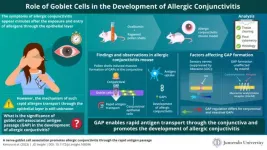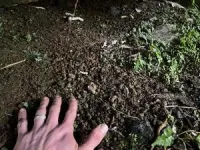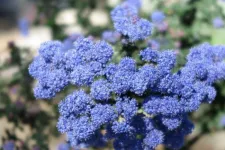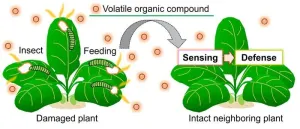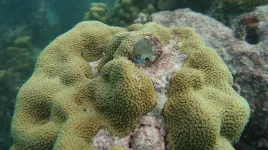When it comes to eye allergies, the transition from allergen contact to bothersome symptoms has always been quick, appearing within a span of a few minutes. The initial stage of allergic conjunctivitis involves the penetration of allergen through the epithelial cell layer (cells covering the outer surface of the body). However, the exact mechanism underlying the rapid allergen transfer has remained a mystery so far.
Fortunately, in a new ground-breaking study published in the journal JCI Insight on October 11, 2023, researchers from Juntendo University in Japan have offered a solution to this puzzle. The research team included Associate Professor Tomoaki Ando along with his colleagues, Dr. Jiro Kitaura, Dr. Meiko Kimura, and Dr. Nobuyuki Ebihara, who set out to unravel the regulatory mechanism in the development of allergic conjunctivitis. “Previously, we reported that the pollen shells and the soluble factors play non-redundant roles in the development of allergic conjunctivitis. At that time, we revealed that the pollen shells stimulate conjunctival epithelial cells to release IL-33, which is an important cytokine for the development of allergy,” explains Dr. Ando. “In this study, we aimed to further elucidate the roles of particulate allergens such as pollen shells in the development of allergic conjunctivitis.”
Accordingly, the researchers used an allergic conjunctivitis mouse model. The conjunctiva of the mice were subjected to topical applications of pollen shells, ovalbumin, ragweed pollen shells, and a combination of ovalbumin and ragweed pollen shells. Next, they performed the conjunctival tissue analysis using advanced tissue clearing techniques and fluorescence imaging. Additionally, flow cytometry was used to identify immune cells within the conjunctiva.
What they discovered was remarkable: the introduction of pollen shells into the eye triggered the rapid formation of what is known as “Goblet cell-associated antigen passages” (GAPs) within the conjunctiva. These specialized passages, formed by specialized epithelial cells called “goblet cells” found on the surface of various moist tissues in the body, have never been observed before in the context of eye allergies. Dr. Ando highlights, “Our study shows that a nerve-driven goblet cell activation enables the rapid transport of allergen through conjunctiva and promotes allergic reaction.”
Goblet cells play a critical role in the rapid acquisition of allergens. In this case, they acted as gatekeepers, allowing swift access for allergens carried by pollen shells. This finding shed new light on how allergens quickly penetrate the eye’s defenses, leading to the rapid onset of allergic conjunctivitis. Interestingly, within the first 10 minutes of exposure to pollen shells, a substantial amount of allergenic material made its way to the stromal cells within the eye. These stromal cells included macrophages and dendritic cells, which are crucial components of the immune system's defense against foreign invaders.
Furthermore, the researchers observed that the sensory nervous system played a vital role in this process. When they applied topical lidocaine or performed trigeminal ablation, both of which affect sensory nerve function, they were able to suppress the rapid formation of GAPs and subsequent allergen acquisition. This highlighted the complex interplay between sensory nerves and the immune response in the development of allergic conjunctivitis.
What sets this discovery apart is that it challenged the commonly held belief that muscarinic acetylcholine receptors regulate GAPs, as pollen shell-stimulated GAP formation remained unaffected by topical atropine. This indicated that there is a difference in the regulation of conjunctival and intestinal GAPs. Moreover, the findings suggested that pollen shell-induced GAP can be a novel target for treatment of conjunctival disease.
This breakthrough can not only demystify the rapid onset of allergic conjunctivitis but also offer hope for more effective treatments in the future. Understanding the role of goblet cells and GAPs in ocular sensitization represents a significant step towards providing relief for the millions of people affected by allergic eye conditions worldwide.
Dr. Ando concludes, “The approach in our study can be extended further to develop new drugs that can control the activation and aid in the treatment of allergic conjunctivitis.”
When it comes to eye allergies, the transition from allergen contact to bothersome symptoms has always been quick, appearing within a span of a few minutes. The initial stage of allergic conjunctivitis involves the penetration of allergen through the epithelial cell layer (cells covering the outer surface of the body). However, the exact mechanism underlying the rapid allergen transfer has remained a mystery so far.
Fortunately, in a new ground-breaking study published in the journal JCI Insight on October 11, 2023, researchers from Juntendo University in Japan have offered a solution to this puzzle. The research team included Associate Professor Tomoaki Ando along with his colleagues, Dr. Jiro Kitaura, Dr. Meiko Kimura, and Dr. Nobuyuki Ebihara, who set out to unravel the regulatory mechanism in the development of allergic conjunctivitis. “Previously, we reported that the pollen shells and the soluble factors play non-redundant roles in the development of allergic conjunctivitis. At that time, we revealed that the pollen shells stimulate conjunctival epithelial cells to release IL-33, which is an important cytokine for the development of allergy,” explains Dr. Ando. “In this study, we aimed to further elucidate the roles of particulate allergens such as pollen shells in the development of allergic conjunctivitis.”
Accordingly, the researchers used an allergic conjunctivitis mouse model. The conjunctiva of the mice were subjected to topical applications of pollen shells, ovalbumin, ragweed pollen shells, and a combination of ovalbumin and ragweed pollen shells. Next, they performed the conjunctival tissue analysis using advanced tissue clearing techniques and fluorescence imaging. Additionally, flow cytometry was used to identify immune cells within the conjunctiva.
What they discovered was remarkable: the introduction of pollen shells into the eye triggered the rapid formation of what is known as “Goblet cell-associated antigen passages” (GAPs) within the conjunctiva. These specialized passages, formed by specialized epithelial cells called “goblet cells” found on the surface of various moist tissues in the body, have never been observed before in the context of eye allergies. Dr. Ando highlights, “Our study shows that a nerve-driven goblet cell activation enables the rapid transport of allergen through conjunctiva and promotes allergic reaction.”
Goblet cells play a critical role in the rapid acquisition of allergens. In this case, they acted as gatekeepers, allowing swift access for allergens carried by pollen shells. This finding shed new light on how allergens quickly penetrate the eye’s defenses, leading to the rapid onset of allergic conjunctivitis. Interestingly, within the first 10 minutes of exposure to pollen shells, a substantial amount of allergenic material made its way to the stromal cells within the eye. These stromal cells included macrophages and dendritic cells, which are crucial components of the immune system's defense against foreign invaders.
Furthermore, the researchers observed that the sensory nervous system played a vital role in this process. When they applied topical lidocaine or performed trigeminal ablation, both of which affect sensory nerve function, they were able to suppress the rapid formation of GAPs and subsequent allergen acquisition. This highlighted the complex interplay between sensory nerves and the immune response in the development of allergic conjunctivitis.
What sets this discovery apart is that it challenged the commonly held belief that muscarinic acetylcholine receptors regulate GAPs, as pollen shell-stimulated GAP formation remained unaffected by topical atropine. This indicated that there is a difference in the regulation of conjunctival and intestinal GAPs. Moreover, the findings suggested that pollen shell-induced GAP can be a novel target for treatment of conjunctival disease.
This breakthrough can not only demystify the rapid onset of allergic conjunctivitis but also offer hope for more effective treatments in the future. Understanding the role of goblet cells and GAPs in ocular sensitization represents a significant step towards providing relief for the millions of people affected by allergic eye conditions worldwide.
Dr. Ando concludes, “The approach in our study can be extended further to develop new drugs that can control the activation and aid in the treatment of allergic conjunctivitis.”
END
